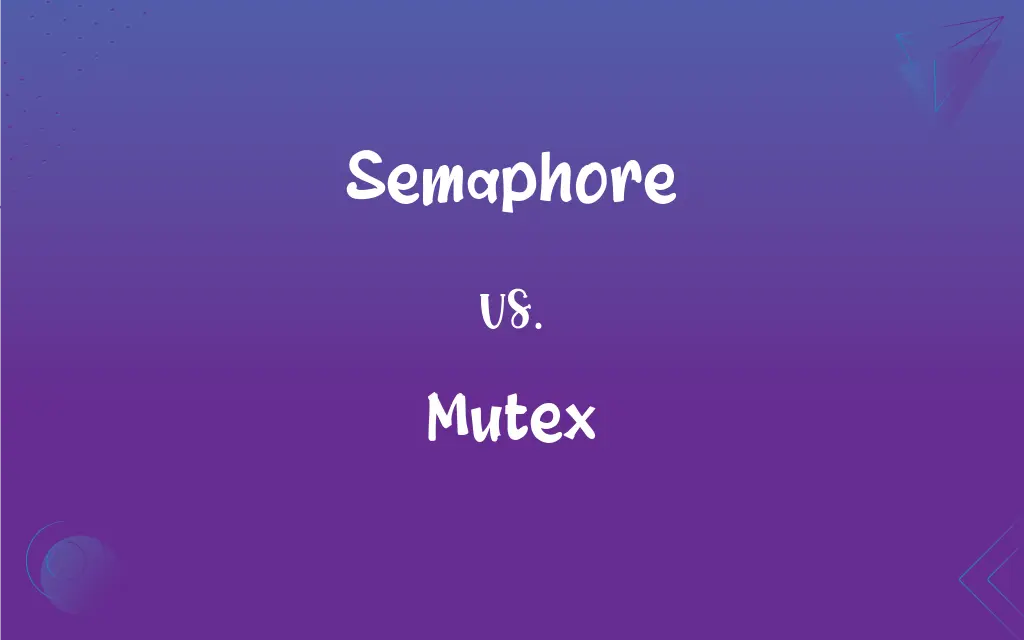Semaphore vs. Mutex: What's the Difference?
Edited by Aimie Carlson || By Janet White || Published on March 21, 2024
A semaphore is a signaling mechanism that controls access by multiple processes to a common resource, while a mutex provides exclusive access to a resource for one process at a time.

Key Differences
A semaphore in programming is a variable or abstract data type used to control access to a common resource by multiple processes in a concurrent system such as a multitasking operating system. A mutex, short for "mutual exclusion," is a synchronization primitive that is used to prevent multiple processes from accessing a critical section simultaneously.
Semaphores can be counting, allowing a certain number of processes to access a resource simultaneously, or binary, which is essentially a mutex. Mutexes, however, are specifically designed to ensure that only one thread accesses a specific resource at a time.
Semaphores are often used for signaling among processes or threads, where one thread signals the availability of a resource to other threads. Mutexes, in contrast, are typically used to protect resources like files, database connections, or state that should not be accessed by more than one thread concurrently.
In a semaphore, the value indicates the number of processes that can simultaneously access the resource, and this value can be incremented or decremented. A mutex, however, is either locked or unlocked, and if a thread attempts to lock an already locked mutex, it will be blocked until the mutex is unlocked.
Semaphores are more flexible than mutexes because they can be used for a variety of synchronization problems, but they can be more complex to use correctly. Mutexes, being simpler, are easier to use but are limited to ensuring mutual exclusion for resources.
ADVERTISEMENT
Comparison Chart
Primary Function
Controls access to a resource by multiple processes.
Provides exclusive access to a resource for one process.
Type
Can be counting or binary.
Always binary.
Use Case
Signaling and managing access for multiple processes.
Protecting critical sections for exclusive single-process access.
Operation
Increment/decrement semaphore value.
Lock/unlock mechanism.
Complexity
More complex, versatile.
Simpler, more specific purpose.
ADVERTISEMENT
Semaphore and Mutex Definitions
Semaphore
A semaphore controls access to a shared resource through the use of a counter.
The semaphore was set to 3, allowing three threads to access the resource.
Mutex
A mutex ensures exclusive access to a resource in multi-threaded programs.
The mutex locked the critical section to prevent data corruption.
Semaphore
Used to resolve issues like deadlocks and process starvation.
Semaphore mechanisms helped prevent deadlocks in the system.
Mutex
It's a locking mechanism for synchronizing threads.
A thread acquired the mutex before accessing the shared variable.
Semaphore
It's a synchronization tool to signal state or manage concurrency.
A semaphore signaled the availability of new data to process.
Mutex
Prevents race conditions in concurrent programming.
To avoid a race condition, the function's critical section was protected by a mutex.
Semaphore
Semaphores can be binary (like mutexes) or counting.
The counting semaphore managed access to the pool of database connections.
Mutex
A binary locking mechanism, either locked or unlocked.
The thread had to wait because the mutex was already locked.
Semaphore
Represents a more general solution for process synchronization.
The application used semaphores for coordinating parallel tasks.
Mutex
Mutex stands for mutual exclusion, essential for thread safety.
Mutexes were used to enforce mutual exclusion in the thread pool.
Semaphore
A visual signaling apparatus with flags, lights, or mechanically moving arms, as one used on a railroad.
Mutex
(programming) An object in a program that serves as a lock, used to negotiate mutual exclusion among threads.
Mutex
To apply a mutex to.
FAQs
Is a mutex binary?
Yes, it's a binary lock (either locked or unlocked).
Can a semaphore be used like a mutex?
Yes, a binary semaphore can function like a mutex.
What is a semaphore used for?
Managing access to shared resources and signaling among processes.
What is a counting semaphore?
A semaphore that allows a fixed number of accesses to a resource.
Are mutexes easier to use than semaphores?
Generally, mutexes are simpler and more straightforward.
Is semaphore a type of lock?
Yes, it's a type of locking mechanism.
How do threads interact with mutexes?
Threads acquire and release a mutex to access shared resources.
What does a mutex do?
Ensures exclusive access to a resource by a single process at a time.
How does a mutex differ from a binary semaphore?
While functionally similar, mutexes are specifically for mutual exclusion.
Can mutexes be used for signaling?
No, mutexes are not used for signaling; they're for mutual exclusion.
Are semaphores more flexible than mutexes?
Yes, they can handle more complex synchronization scenarios.
What is mutual exclusion in mutex?
It refers to the exclusive access to a resource by one process.
Can semaphores cause deadlocks?
If not used carefully, semaphores can lead to deadlocks.
What's the primary use of a mutex?
To protect critical sections in concurrent programming.
Can multiple threads acquire a mutex simultaneously?
No, only one thread can hold a mutex at a time.
What problems do semaphores solve?
Deadlocks, resource starvation, and managing concurrent access.
What is semaphore initialization?
Setting the initial count or state of the semaphore.
Can a semaphore value be negative?
Yes, indicating the number of processes waiting for the resource.
How do counting semaphores work?
They keep a count of the number of allowed accesses to a resource.
Is a mutex reentrant?
It depends on the implementation; some mutexes are reentrant.
About Author
Written by
Janet WhiteJanet White has been an esteemed writer and blogger for Difference Wiki. Holding a Master's degree in Science and Medical Journalism from the prestigious Boston University, she has consistently demonstrated her expertise and passion for her field. When she's not immersed in her work, Janet relishes her time exercising, delving into a good book, and cherishing moments with friends and family.
Edited by
Aimie CarlsonAimie Carlson, holding a master's degree in English literature, is a fervent English language enthusiast. She lends her writing talents to Difference Wiki, a prominent website that specializes in comparisons, offering readers insightful analyses that both captivate and inform.































































